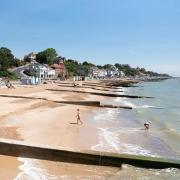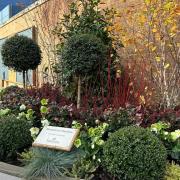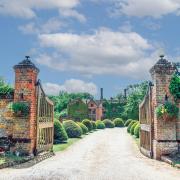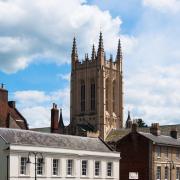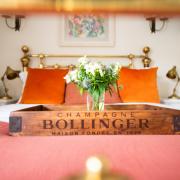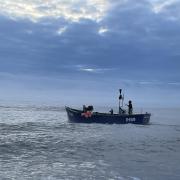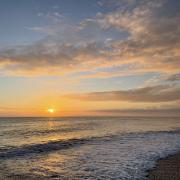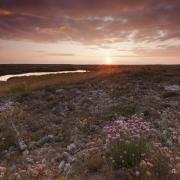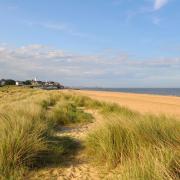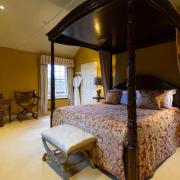February is the month for romance and we want you to fall in love with Suffolk all over again. Here are some familiar favourite places, with romantic stories to tell, you’ll just want to keep coming back to

Framlingham
The focus of Fram is the castle on the hill (english-heritage.org.uk), where Mary Tudor famously fled to escape the political machinations in the wake of her brother Edward VI's death. Here she gathered her supporters and was eventually proclaimed Queen of England in 1553. The magnificent 12th century castle walls and towers still stand, where you can immerse yourself in the romance of Mary's story and enjoy spectacular views of Framlingham mere and the surrounding countryside. There are superb countryside walks and also a very good town trail (thesuffolkcoast.co.uk/shares/Framlingham-Town-Trail.pdf) which highlights 27 different historic sites around Framlingham, each with a story to tell.

Flatford
The backdrop to the life of one of our greatest painters, John Constable, Flatford is at the heart of the Dedham Vale National Landscape (formerly Area of Outstanding Natural Beauty). Here you can explore the countryside Constable painted; riverside meadows, woodland, fields and miles of footpaths, even hire a boat to row the River Stour. You can see the historic sites that feature in his work including Valley Farm, Willy Lott’s House, Flatford Mill and The Granary, and the Lock, and learn about Constable's career and life, including his marriage to Maria Bicknell, which led to her being disinherited by her grandfather who disapproved of the struggling artist. (nationaltrust.org.uk/visit/suffolk/flatford)

Sudbury
Famous as the birthplace of painter Thomas Gainsborough, Sudbury has a long history of silk weaving and grew wealthy in the middle ages as a wool town, the legacy of which is 242 listed buildings. Follow the The Talbot Trail, 14 statues that depict fascinating episodes in the town’s history. Among others, you'll meet Archbishop Simon of Sudbury, inventor of the Poll Tax and slaughtered in the Peasants' Revolt; 101 Dalmations marking the spot where a scene from the film was made; William Kemp dancing his way from London to Norwich in 1599; and The Great Blondin, who demonstrated his trapeze skills here in 1872. (sudbury-tc.gov.uk/talbot-trail).

Ickworth
Until 1956, this romantic, Italianate palace was home to the Hervey family, notoriously John, Lord Hervey (1696–1743), son of the 1st Earl of Bristol. A successful politician, he became Keeper of the Privy Seal and a member of the Privy Council, and was one of the most famous figures of his time. Yet his life was full of scandal. He was known for his bisexual relationships and effeminate style, for sharing a mistress with the Prince of Wales, and for having a 10-year relationship with another man, despite remaining married to Molly Lepel, who he wed in secret in 1720. Discover Ickworth's many artistic treasures, its gardens and acres of parkland (nationaltrust.org.uk/visit/suffolk/ickworth-estate).

Thorpeness
Stuart Ogilvie's romantic vision, a private fantasy holiday village for friends and their families, with an exclusive country club, tennis courts, swimming pool, clubhouse and golf course designed by the eminent James Braid. The pretty mock Tudor houses and fairytale House in the Clouds (disguising a water tower) you see today are just as he imagined it in 1910 when he bought the hamlet, as is the huge Meare, inspired by Peter Pan author J M Barrie, a personal friend of the Ogilvies. The Meare's landings and tiny islands have names from the book, such as the pirates' lair and Wendy's house. Stay a while and enjoy the romance of it all.

Orford
This peaceful coastal village has witnessed some extraordinary history. It's dominated by the castle, built by Henry II between 1165 and 1173, with a unique polygonal keep, which is remarkably intact. Here you can discover Orford's story, including the strange legend of the Wild Man of Orford. Not long after the castle was built, some local fishermen discovered a strange creature in their nets – like a man, but naked and covered with hair. They brought this 'merman' to the castle where he stayed for several months, saying nothing, living on a diet of fish, until one day they took him for a swim and he slipped beneath the waves... (english-heritage.org.uk/visit/places/orford-castle).

Polstead
One of the most famous romantic tragedies belongs to Polstead. In 1827, villager Maria Marten was shot dead by her lover, William Corder, son of a local farmer, in the Red Barn not far from Maria's home. They had arranged to meet there before eloping to Ipswich. Corder sent letters to Marten's family claiming she was well, but after her stepmother dreamt that Maria had been murdered, her body was discovered in the barn. Corder was traced to London and returned to Suffolk where he was found guilty of murder in a well publicised trial. In 1828, he was hanged at Bury St Edmunds. His death mask is in Moyses Hall Museum. (moyseshall.org) There's a delightful walk around Polstead that takes you near the site of the Red Barn. (polstead.onesuffolk.net).

Lavenham
Spend some time exploring the enchanting medieval streets of Lavenham and you soon discover all sorts of romantic connections from the house in Shilling Street where Twinkle, Twinkle Little Star was first composed, to the splendid Guildhall, to De Vere House which starred as Godric's Hollow in Harry Potter and the Deathly Hallows – Part 1. Lavenham grew wealthy on the wool trade and its legacy is in the stunning, richly timbered merchants' houses that line its streets, and in its magnificent church. There's a lot to see here and in the surrounding villages. (lovelavenham.co.uk/lavenham-guided-walks).

Dunwich
What could be more tragically romantic than a medieval town upon a cliff top, a thriving seaport, home to 3,000 people and eight churches, struck by a massive storm surge and vanishing beneath the waves, leaving little trace except the faint tolling of bells from sunken churches? That's the fascinating story of Dunwich, Suffolk's 'Lost City', but you can learn more from the village's excellent museum, where a detailed model shows you what Dunwich was like at the height of its powers in the 13th century. Wander around the ruins of Greyfriars friary, stroll along the beach and explore the heath. (nationaltrust.org.uk/visit/suffolk/dunwich-heath-and-beach)

Iken
There's nowhere quite like Iken, a beautiful, unspoilt, peaceful place. Threading your way from Snape Maltings, through the reeds, out along the River Alde to the little hamlet is like travelling back in time. This is The Anchorage, formerly an island in a marsh by the estuary, and the most likely site of Saint Botolph's Abbey, Ikenhoe, now St Botolph's church. During excavations in 1977 Dr Stanley West discovered part of a large stone Saxon cross incorporated into the wall of the church tower, carved with the heads of dogs and wolves, symbols traditionally recognised as St Botolph's emblems during the Middle Ages. It's now on display in the church. In summer you can hire canoes at Iken Cliff and explore the river.





